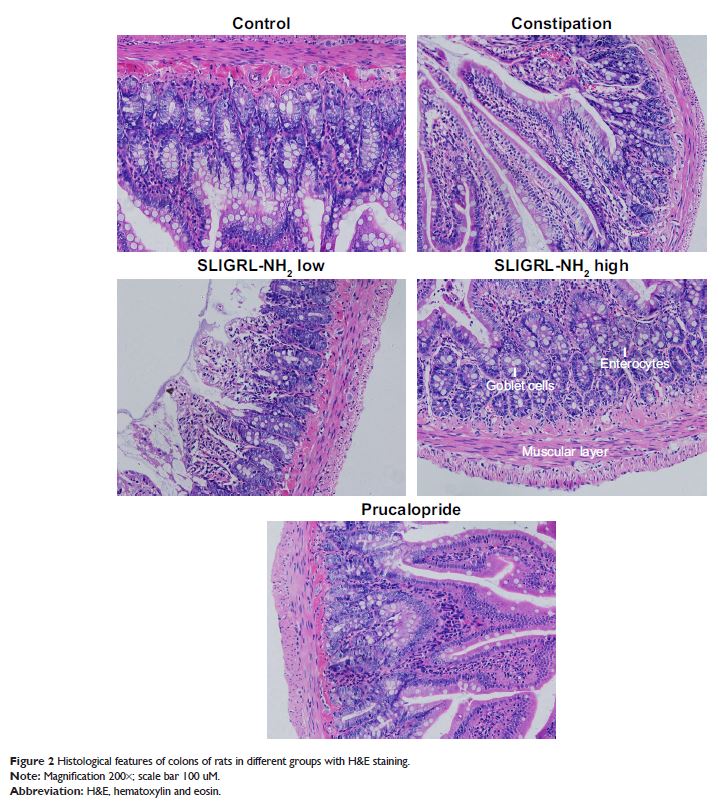108605
论文已发表
注册即可获取德孚的最新动态
IF 收录期刊
- 3.4 Breast Cancer (Dove Med Press)
- 3.2 Clin Epidemiol
- 2.6 Cancer Manag Res
- 2.9 Infect Drug Resist
- 3.7 Clin Interv Aging
- 5.1 Drug Des Dev Ther
- 3.1 Int J Chronic Obstr
- 6.6 Int J Nanomed
- 2.6 Int J Women's Health
- 2.9 Neuropsych Dis Treat
- 2.8 OncoTargets Ther
- 2.0 Patient Prefer Adher
- 2.2 Ther Clin Risk Manag
- 2.5 J Pain Res
- 3.0 Diabet Metab Synd Ob
- 3.2 Psychol Res Behav Ma
- 3.4 Nat Sci Sleep
- 1.8 Pharmgenomics Pers Med
- 2.0 Risk Manag Healthc Policy
- 4.1 J Inflamm Res
- 2.0 Int J Gen Med
- 3.4 J Hepatocell Carcinoma
- 3.0 J Asthma Allergy
- 2.2 Clin Cosmet Investig Dermatol
- 2.4 J Multidiscip Healthc

蛋白酶激活受体 2 激动剂 SLIGRL-NH2 对洛哌丁胺诱导的 Sprague-Dawley 大鼠便秘模型的治疗作用及相关机制
Authors Zhang Y, Ge T, Xiang P, Mao H, Tang S, Li A, Lin L, Wei Y
Received 22 December 2017
Accepted for publication 24 April 2018
Published 1 August 2018 Volume 2018:12 Pages 2403—2411
DOI https://doi.org/10.2147/DDDT.S160628
Checked for plagiarism Yes
Review by Single-blind
Peer reviewers approved by Dr Cristina Weinberg
Peer reviewer comments 3
Editor who approved publication: Dr Anastasios Lymperopoulos
Purpose: To investigate the therapeutic effects of protease-activated
receptor 2 (PAR-2) agonist SLIGRL-NH2 on
loperamide-induced Sprague-Dawley (SD) rat constipation animal models.
Materials and methods: Loperamide was injected subcutaneously to induce
constipation twice a day for 3 days. SD rats (n = 30) were randomly divided
into five groups: non-constipation group (control, n = 6), constipation group
(constipation, n = 6), constipation + SLIGRL-NH2 low-dosage
group (SLIGRL-NH2 low, n=6), constipation +
SLIGRL-NH2 high-dosage group (SLIGRL-NH2 high, n = 6), and constipation + prucalopride
(positive control, n = 6). The SLIGRL-NH2 low group
and SLIGRL-NH2 high group were administered
with 2.5 μmol/kg and 5 μmol/kg SLIGRL-NH2, respectively,
and the prucalopride group received 2 mg/kg prucalopride. The control and
constipation group received 1× PBS under the same pattern. SLIGRL-NH2 and prucalopride were orally administrated
once daily for 7 days. On the final day of oral administration, food intake,
water intake, the number of stool pellets, weight, and fecal water content was
calculated; moreover, the colons of rats in different groups were collected and
histological features were examined by hematoxylin and eosin staining;
furthermore, the expression of anoctamin-1 was determined by
Immunohistochemical methods, and the expressions of c-kit and PAR-2 were
examined using real-time quantitative polymerase chain reaction and Western
blot methods; finally, the expressions of neurotransmitter vasoactive
intestinal peptide (VIP) and substance P (SP) were examined using enzyme-linked
immunosorbent assay methods.
Results: The feeding and excretion behaviors, intestinal
transit ratio, and the histological feature of the colon in the constipated
rats were all improved by SLIGRL-NH2 treatment;
moreover, SLIGRL-NH2treatment induced significant
increase in the expression of PAR-2 and also increased number of interstitial
Cajal cells. Furthermore, SLIGRL-NH2 also
decreased the contents of the inhibitory neurotransmitter VIP and increased the
expression of the excitatory neurotransmitter SP. High dose of SLIGRL-NH2 has shown similar anti-constipation effects as
prucalopride.
Conclusion: These results suggested that SLIGRL-NH2 can enhance gastrointestinal transit and
alleviate in rats with loperamide-induced constipation.
Keywords: constipation,
PAR-2, SLIGRL-NH2, loperamide, interstitial Cajal
cells
